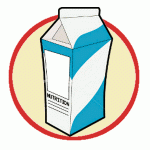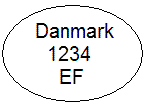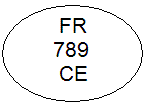Dairy products – what does it mean?

A38 (trade name) – is milk (sweet, light or skim) acidified with lactic acid bacteria acidophilus and thick milk bacterial culture.
Acidophilus – Milk is acidified with lactic acid bacteria Lactobacillus acidophilus.
Cream fraiche – is sour cream. The product is available in three variants depending on the fat percentage. Cremefraiche 38% and 18%, and Fraiche 9%.
Cultura (trade name) – is soured whole milk. The acidification is made with the bacterium Streptococcus termophilus and lactic acid bacteria Acidophilus and Bifidus.
Cultura drik (trade name) – is soured skimmed milk. The acidification is made with the bacterium Streptococcus termophilus and lactic acid bacteria Acidophilus and Bifidus.
The consistency is more fluid than Cultura.
Fromage frais / -blanc – is fresh cheese and contains pasteurized skimmed milk, lactic acid bacteria and possibly. rennet. The difference between fromage frais / -blanc lies in the consistency.
Fløde / Cream – is a milk product with a fat content of at least 8%.
Fløde / Cream 9% – is a milk product with a fat content of 9%.
Fløde / Cream 13% – is a dairy product with a fat content of 13%.
Creamy yogurt – cream is soured with yoghurt culture and at least 8% fat.
Gammeldags Kærnemælk / Old-fashioned buttermilk – is a byproduct in the manufacture of butter.
Homogenisering af mælk / Homogenization of milk – is a treatment of milk that prevents the gathering of cream (fat balls) on the milk surface.
Before homogenization, the milk’s fat balls are of different sizes.
After homogenization the fat size is smaller and the milk is more uniform.
Jersey 0.5% (trade name) – is organic skimmed milk from Jersey cows.
Jersey milk is unhomogenized and pasteurized and the fat content is at most 0.5%.
Kakaomælk / Cocoa milk – is milk added with cocoa.
If the product is sterilized, it may be called “chocolate milk”.
Kefir – is an acidified milk product made from pasteurized homogenized whole milk (possibly skimmed milk) and a bacterial culture mixture of yeast fungi (kefir fungus) and lactic acid bacteria.
Kokos / Coconut milk – consists of the juice of pressed coconut added water.
The fat content of coconut milk is approx. 20% for the regular version and approx. 7% for the light edition. Coconut milk has nothing to do with cow’s milk.
Koldskål / Buttermilk – is buttermilk or old-fashioned buttermilk, acidified with lactic acid culture , added pasteurized egg, sugar, vanilla sugar or vanilla kernel and lemon juice or concentrate.
Identification mark on dairy products – is a control number / brand of the company / dairy who has manufactured the product. The control number must be on all milk products within the EU.
The check mark must be in an oval frame and can look like this:



Other abbreviations than EC for the EU can be used, for example, Germany often uses EG and France CE.
Kærgården (trade name) – is a mixed product made from fermented cream, uncured rapeseed oil and salt. 75% of the fat is milk fat and 25% is vegetable fat.
Kærgården is to lubricate the bread right from the fridge.
Kærnemælk / Buttermilk – is pasteurized, homogenized and sour milk that must contain 0.3% -1% fat.
Laktose / Lactose – is milk sugar and is only found in milk and dairy products.
Letmælk / Light milk – is milk with a fat content of at least 1.5% and not more than 1.8%.
Minimælk (trade name) – is skimmed milk with a fat content of not more than 0,5%.
Mælkeproteiner / Milk proteins – are casein and whey proteins found in milk.
Mælkepulver / Milk powder – is milk from which the water has been removed by evaporation of, for example, sweet, light or skimmed milk.
Mælkesukker / Milk sugar – see lactose.
Mælkesyrebakterier / Lactic acid bacteria – are bacterial cultures such as Lactobacillus and Streptococcus.
Mælkesyrekultur / Lactic acid culture in sour milk products – lactic acid bacteria.
Pasteurisering af mælk / Pasteurization of milk – is a mild heat treatment of milk, with the purpose of harmlessly causing pathogenic bacteria and achieving a longer shelf life of milk.
Piskefløde / Whipped cream – is a milk product with a fat content of at least 34%.
Skummetmælk / Skimmed milk – is milk with a fat content of not more than 0.5%. Usually, skimmed milk contains 0.1% fat.
Smør / Butter – consists of at least 80% and not more than 90% milk fat. There are varieties of different salt contents (salted (about 1% salt), lettuce salted (about 0.6% salt) and unsalted butter).
Sterilisering / Sterilization – is a heat treatment that kills all bacteria present.
Syrnede mælkeprodukter / Soured milk products – are milk products which are acidified with bacterial cultures to produce a more solid consistency, develop a variety of flavors and flavors and achieve a longer shelf life.
Sødmælk / Sweet milk – is milk with a fat content of at least 3.5%.
Tykmælk / Thick Milk – is pasteurized whole milk acidified with lactic acid culture .
Uhomogeniseret mælk / Unhomogenized milk – is milk, where the cream (grease balls) rises to the surface when left. Therefore, shake before use – for example, organic milk is unhomogenized.
UHT-behandling af mælk * / UHT treatment of milk * – is a powerful heat treatment and is preferably used to harm disease-causing bacteria and prolong the durability of milk, cream and cocoa milk.
Shelf life after UHT treatment up to approx. 3 months.
Do not store in a refrigerator before opening the carton.
Valle / Whey – is a byproduct that is produced by cheese production.
Ylette – is soured whole milk with concentrated milk protein.
Ymer – is soured whole milk with concentrated milk protein.
Yogurt – is soured (sweet, light or skim) milk. The acidification is made with the bacteria Streptococcus thermophilus and Lactobacillus bulgaricus.
* UHT – Ultra Høj Temperatur / UHT – Ultra High Temperature
Source: Varefakta.dk
